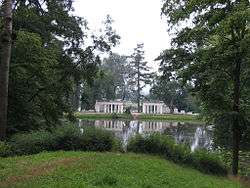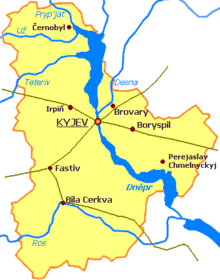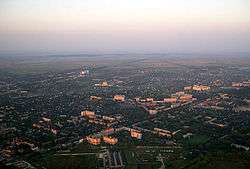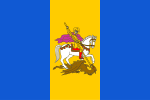Kiev Oblast
| Kyiv Oblast Київська область Kyivs’ka oblast’ | |||
|---|---|---|---|
| Oblast | |||
| |||
| Nickname(s): Київщина (Kyivshchyna) | |||
_in_Ukraine.svg.png) | |||
| Country |
| ||
| Administrative center | Kiev | ||
| Government | |||
| • Governor | Maksym Melnychuk[1] | ||
| • Oblast council | ? seats | ||
| • Chairperson | Mykola Babenko (Petro Poroshenko Bloc) | ||
| Area | |||
| • Total | 28,131 km2 (10,861 sq mi) | ||
| Area rank | Ranked 8th | ||
| Population (September 1, 2013[2]) | |||
| • Total |
| ||
| • Rank | Ranked 10th | ||
| Demographics | |||
| • Average salary | UAH 4.174[3] (2011) | ||
| • Salary growth | +28.73 | ||
| Time zone | EET (UTC+2) | ||
| • Summer (DST) | EEST (UTC+3) | ||
| Postal code | 07-09 | ||
| Area code |
+380 44 (Kiev city) +380 45 (outside Kiev city)[4] | ||
| ISO 3166 code | UA-32 | ||
| Vehicle registration | AI | ||
| Raions | 25 | ||
| Cities (total) — Regional cities |
26[5] 12[5] | ||
| Urban-type settlements | 30 | ||
| Villages | 1,127[5] | ||
| FIPS 10-4 | UP26 | ||
| Website | www.kyiv-obl.gov.ua | ||
Kiev Oblast or Kyiv Oblast[6][7][8][9][10] (Ukrainian: Київська область, translit. Kyivs’ka oblast’; also referred to as Kyivshchyna – Ukrainian: Київщина) is an oblast (province) in central Ukraine. The administrative center of the oblast is the city of Kiev (Ukrainian: Київ, Kyiv), which also serves as the capital of Ukraine. Despite being located in the center of the Kiev Oblast, and hosting the governing bodies of the oblast, Kiev itself is a self-governing city with special status and not under oblast jurisdiction.
Kiev Oblast neither corresponds to nor is limited to the unofficially-designated Kiev metropolitan area although it is significantly dependent on the urban economy and transportation of the latter.
The largest city in the oblast is Bila Tserkva.
The Chernobyl Exclusion Zone is technically located within the northernmost part of the Kiev Oblast but access to the Zone is prohibited to the public and it is administered separately from the oblast.
Geography
Kiev Oblast has a total area of 28,100 km2 (10,849 sq mi) (approximately 35 times the area of Kiev city) and is located in north-central Ukraine. On the west it borders the Zhytomyr Oblast, on the Southwest – Vinnytsia Oblast, on the South – Cherkasy Oblast, on the Southeast – Poltava Oblast, on the East and Northeast – Chernihiv Oblast, and on the North – Homyel Voblasts of Belarus.
The oblast is equally split between the both banks of Dnieper River (Dnipro) north and south of Kiev. Other significant rivers in the oblast are the Dnieper's tributaries: Pripyat (Prypiat) (R), Desna (L), Teteriv (R), Irpin' (R), Ros' (R) and Trubizh (L).
The length of the Dnipro River within the boundaries of the oblast totals 246 km (153 mi). The oblast has a total number of 177 rivers intersecting the region; 13 reservoirs (the most notable ones being Kyiv Reservoir and the Kaniv Reservoir), over 2000 ponds, and approximately 750 small lakes.
Climate
The climate of Kiev Oblast is characteristic of the Polesia area and other neighboring forested areas. The oblast has a moderately continental climate with relatively mild winters and warm summers. The temperatures range from −6.1 °C (21.0 °F) in January to 19.2 °C (66.6 °F) degrees in July.

Vegetation
Kiev Oblast has small mountains and slopes on the right bank of the Dnieper River. This entire area is surrounded by a continuous belt by greenery and forests. The oblast's "green area" covers 436 km2 (168 sq mi), characterized by 250 different sorts of trees and bushes.
History
Kiev Oblast was officially created as part of the Ukrainian Soviet Socialist Republic on February 27, 1932.
Earlier historical administrative units that later became the territory of the oblast include the Kiev Voivodeship under the Polish-Lithuanian Commonwealth and Grand Duchy of Lithuania, and the Kiev Governorate under the Russian Empire. The northern part of the oblast belongs to the historical region of Polesia (Polissia).
In Kiev region, there was a specific folk icon-painting style much influenced by the Kiev Pechersk Lavra painting school. Saints were depicted on the deep purple or black background, their clothes dark, their haloes dark blue, dark green or even black, outlined by thin white dotted contours. The Kiev region's icons' collection is the part of the exhibition of the Museum of Ukrainian home icons in the Historical and cultural complex "The Radomysl Castle".[11]
The current borders of the oblast were last set following the Chernobyl accident in 1986. Administrative oversight of the new city of Slavutych, which was constructed as part of the Chernihiv Oblast, was then transferred to the Kiev Oblast (see Chernobyl zone below).
Points of interest
The following historic-cultural sites were nominated for the Seven Wonders of Ukraine.
- Pereiaslav-Khmelnytskyi museum of folk architecture
- Liutych platzdarm
- Ivan Kozlovsky villa
- Dobranychivka settlement
- Saint Pokrov Church (Parkhomivka)
- Museum-villa of Ekaterina Bilokur
- Landscape garden Oleksandria
Administrative divisions
The oblast is subdivided into 25 raions (administrative districts). It consists of 26 cities, 30 towns, and more than 1,000 villages.
The following data incorporates the number of each type of administrative divisions of Kiev Oblast:[5]
- Administrative Center – 1 (Kiev)
- Raions – 25;
- Settlements – 1183, including:
- Villages – 1127;
- Cities/Towns – 56, including:
- Urban-type settlement – 30;
- Cities – 25, including:
- Cities of oblast' subordinance – 13;
- Cities of raion subordinance – 14;
- Selsovets – 605.
As with other oblasts of Ukraine, the head of the Kiev Oblast State Administration (governor) is appointed by the President of Ukraine and subordinated to the Cabinet of Ministers of Ukraine. Local self-government body is the popularly-elected Kiev Oblast Rada, chaired by a Speaker (elected from within counclipersons).
The "exclaves"
The municipality of Slavutych is located within the borders of the neighboring Chernihiv Oblast on the eastern bank of the Dnieper river and the municipality has no common border with the Kiev Oblast. Still, Slavutych is administrated by the Kiev Oblast authorities (being a kind of administrative exclave).
Similarly, the town of Kotsiubynske, which is located within the borders of Kiev city (which is itself surrounded by the Kiev Oblast), is administrated by the Irpin city council.
Chernobyl zone
Main Article: Chernobyl Exclusion Zone
The north-western end of the oblast is a part of the Chernobyl Exclusion Zone due to the radioactive contamination caused by the Chernobyl nuclear reactor accident. The largest cities within zone are Chernobyl and Prypiat, which are now abandoned (see ghost towns). The city of Slavutych was built outside of the zone to host evacuated residents of Prypyat and personnel of the zone installations.
Important cities and towns
Important cities and towns of Kiev Oblast include:
|
- Biggest settlements (population in thousands)
- Bila Tserkva – 200.1
- Brovary – 86.8
- Boryspil – 54.0 (not counting two subordinated villages)
- Fastiv – 52.0
- Irpin – 40.6 (not counting four subordinated towns)
Governors
- Vira Ulianchenko
- Viktor Vakarsh (acting) May 2009 – ?
- Anatoliy Prysyazhnyuk
- Volodymyr Shandra (2014 - 2016)[1]
- Maksym Melnychuk (since 3 February 2016)[1]
Demographics
Kiev Oblast's largest nationality group are Ukrainians (1,684,800 people, or 92.5%), followed by Russians, Jews, Belarusians, Poles, and others. The current estimated population (excluding Kiev) is around 1.72 million (as of 2013). The population density is 63.01/km².
The urban population, according to the 2001 Ukrainian Census data, accounted for 1,053,500 people, or 57.6%, and the rural population – for 774,400 people, or 42.4%.[12]
According to the data, the number of men accounted for 845,900 people, or 46.3%, that of women – 982,000 people, or 53.7%.
Age structure
- 0-14 years: 14.9%
 (male 132,559/female 123,816)
(male 132,559/female 123,816) - 15-64 years: 69.8%
 (male 576,559/female 621,753)
(male 576,559/female 621,753) - 65 years and over: 15.3%
 (male 84,026/female 177,360) (2013 official)
(male 84,026/female 177,360) (2013 official)
Median age
- total: 39.7 years

- male: 36.3 years

- female: 43.0 years
 (2013 official)
(2013 official)
Age structure of Kiev City
- 0-14 years: 14.1%
 (male 203,453/female 192,111)
(male 203,453/female 192,111) - 15-64 years: 73.3%
 (male 962,391/female 1,093,183)
(male 962,391/female 1,093,183) - 65 years and over: 12.6%
 (male 129,293/female 223,285) (2013 official)
(male 129,293/female 223,285) (2013 official)
Median age of Kiev City
- total: 37.6 years

- male: 35.4 years

- female: 39.9 years
 (2013 official)
(2013 official)
Economy
Industry
Kiev Oblast's main industry's include: power production, food, chemical and petrochemical industries, mechanical engineering and metal-working. The national share of tire production for automobiles constitutes – 63%, excavators – 53%, paper and cardboard – 40%, hoisting cranes – 39%. In general, the oblast has a total of 330 licensed industrial enterprises and 742 smaller industrial enterprises.[13] The Boryspil Bus Plant in Prolisky produces 1,700 buses per year of various modifications, and several other auto-industry factories are also located in the oblast'.
Agriculture
In addition to industry, the oblast also has a developed agriculture production. In 1999, the gross grain yield in the region was about 1,118,600 tons, sugar-beets – 1,570,900 tons, sunflower seeds – 18,1 thousand tons, potatoes – 669,200 tons. The region also produced 156,900 tons of meat, 738,500 tons of milk and 855,2 million eggs. At the beginning of 1999, there were 1,130 registered farms within the oblast.[13]
Transportation

Kiev Oblast has a highly developed rail transport system. The total length of the oblast's working railroad lines is 88 km (as of 1985). Through the territory of the oblast pass the: Moscow—Kiev—Lviv, Kiev—Dnipropetrovsk—Donetsk and other railroad routes. In addition to inter-Ukraine and international rail routes, local Elektrychka lines also pass through the oblast: Kiev—Fastiv—Koziatyn, Kiev—Fastiv—Myronivka, Kiev—Teteriv, Kiev—Nizhyn, and Kiev—Yahotyn.
The length of the oblast's automobile roads totals 7,760 km, including 7,489 km of paved roads. The main roads passing thorough the oblast include:
- Saint Petersburg—Kiev—Odessa (M-01/M-05 route)
- Kiev-Kovel-Lublin (M-07 route)
- Voronezh—Kharkiv-Kiev-Lviv-Krakov (E-40, M-06/M03 route)
- Luhansk-Dnipropetrovsk-Kiev (M-04 route)[14][15]
The oblast's main airports include two international airports: the Boryspil Airport and the Gostomel (Antonov) Cargo Airport. Ukrainian military airbases are located in the cities of Bila Tserkva and Uzyn.
Strategic gas-pipelines located in the oblast include Urengoy—Pomary—Uzhhorod, and Shebelynka—Poltava—Kiev.
Education
Kiev Oblast has 795 state-run schools of general education, 219 (27.5%) of which are situated in urban areas and 576 (72.5%) of which – in rural areas.[16] These schools are attended by 232,260 students, 141,416 (60.6%) which attend urban schools, and 98,944 (39.4%) which attend rural area schools.[16] In addition, there are 12 evening schools with an enrollment of over 6,000 students, 15 private institutions containing about 7,000 students, 23 vocational schools containing over 14,300 students, 22 higher schools with an enrollment of over 34,900 students), and 52 home-school institutions containing over 48,700 children.[16] There are also 756 institutions of pre-school education attended by a total of 44,400 children, 52 home-school institutions, 22 vocational institutions, having an enrollment of with 17,300 students.[16]

Also, educational institutions for orphans, physically and mentally disabled children represent an important component of Kiev Oblast's educational system.
In addition to general education schools, the oblast has educational institutions specifically for gifted children, including:
- Fastiv Regional Natural and Mathematic School
- Kiev Regional Lyceum of Physical Education and Sports
- Stritiv Higher Pedagogical School of Kobza Music
- Brovary Higher School of Physical Education (training ground for several world- and Olympic champions).
Nomenclature
Most of Ukraine's oblasts are named after their capital cities, officially referred to as "oblast centers". The name of each oblast is a relative adjective, formed by adding a feminine suffix to the name of respective center city: Kiev (Kyiv in transliterated Ukrainian) is the center of the Kyivs’ka oblast' (Kiev Oblast). Most oblasts are also sometimes referred to in a feminine noun form, following the convention of traditional regional place names, ending with the suffix "-shchyna", as is the case with the Kiev Oblast, Kyivshchyna.
Kiev is the traditional English name for the administrative center of the Kiev Oblast, but the Ukrainianized versions (transliterated from the Ukrainian language) Kyiv and Kyiv Oblast are sometimes also used.
Notes
a. ^ These neighboring settlements are practically merged into a conurbation
See also
References
- 1 2 3 (Ukrainian) Maksym Melnychuk Poroshenko appointed Head of Kyiv Regional State Administration, hromadske.tv (3 February 2016)
Poroshenko sees direct elections of regional administration heads as threat to Ukraine's federalization, Interfax-Ukraine (3 February 2016) - ↑ "State Statistics Committee of Ukraine". Retrieved September 1, 2013.
- ↑ The average salary in Kiev reached 4 thousand UAH
- ↑ announcement of new telephone codes in Kyiv Post
- 1 2 3 4 Statistical Yearbook of Kyiv Region for 2007, Main Department of Statistics in Kyiv Region, 2008
- ↑ Kyiv Oblast Government Portal
- ↑ State Archives of Kyiv Oblast
- ↑ Yahoo! Kyiv Oblast Weather Forecasts
- ↑ INVESTMENT PASSPORT of Kyiv oblast
- ↑ Kyiv Oblast’s choices for green tourists
- ↑ Богомолець. О. "Замок-музей Радомисль на Шляху Королів Via Regia". — Київ, 2013
- ↑ Ukrcensus.gov.ua – Kyiv region URL accessed on November 26, 2006
- 1 2 Cabinet of Ministers of Ukraine – Kyiv Region URL accessed on November 26, 2006
- ↑ Київська область: Карта автошляхів. – К.: ДНВП "Картографія", 2006
- ↑ Україна: Карта автомобільних шляхів. – К.: Укрегеодезкартографія, 1993.
- 1 2 3 4 "Secondary and Higher Education". Kyiv Regional State Administration. Retrieved December 25, 2006.
- Information Card of the Region – Official site of the Cabinet of Ministers of Ukraine
External links
- kyiv-obl.gov.ua – Official website of Kiev Oblast Administration
- patent.net.ua – Symbols of Kiev Oblast
- Wormwood Forest – a commercial site, however, containing free-access Chernobyl-related maps and photogallery (English)/(Ukrainian)
- Baryshivka site in the Kiev Oblast (Ukrainian)
- Kyiv Oblast from website Ukraine-CityGuide (Ukrainian)/(Russian)/(English)
- The Official Site of the Radomysl Castle (Ukrainian)/(Russian)/(English)
| ||||||||||||||||||||||||||||
| ||||||||||||||||||||||||||
Coordinates: 50°15′N 30°30′E / 50.250°N 30.500°E
|

